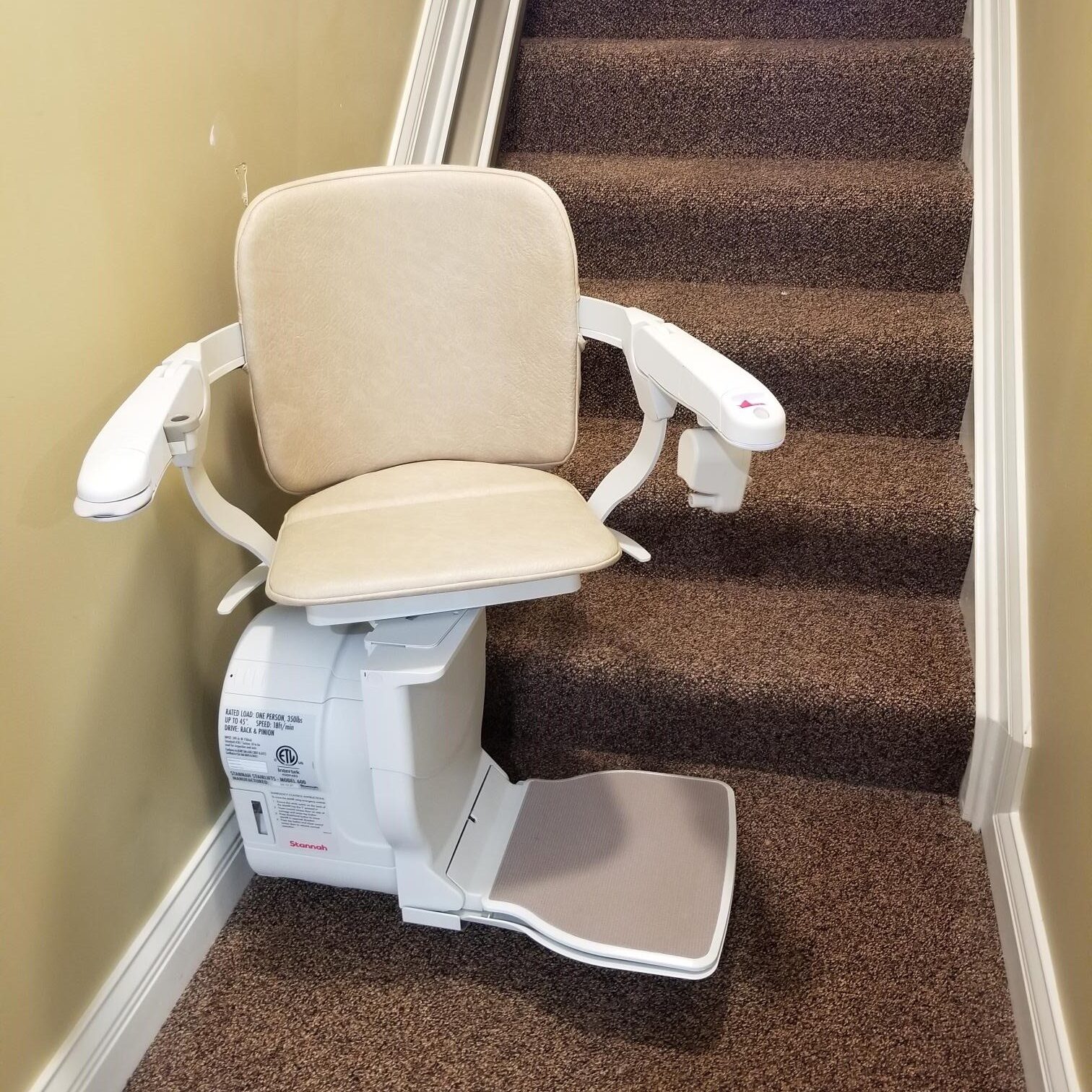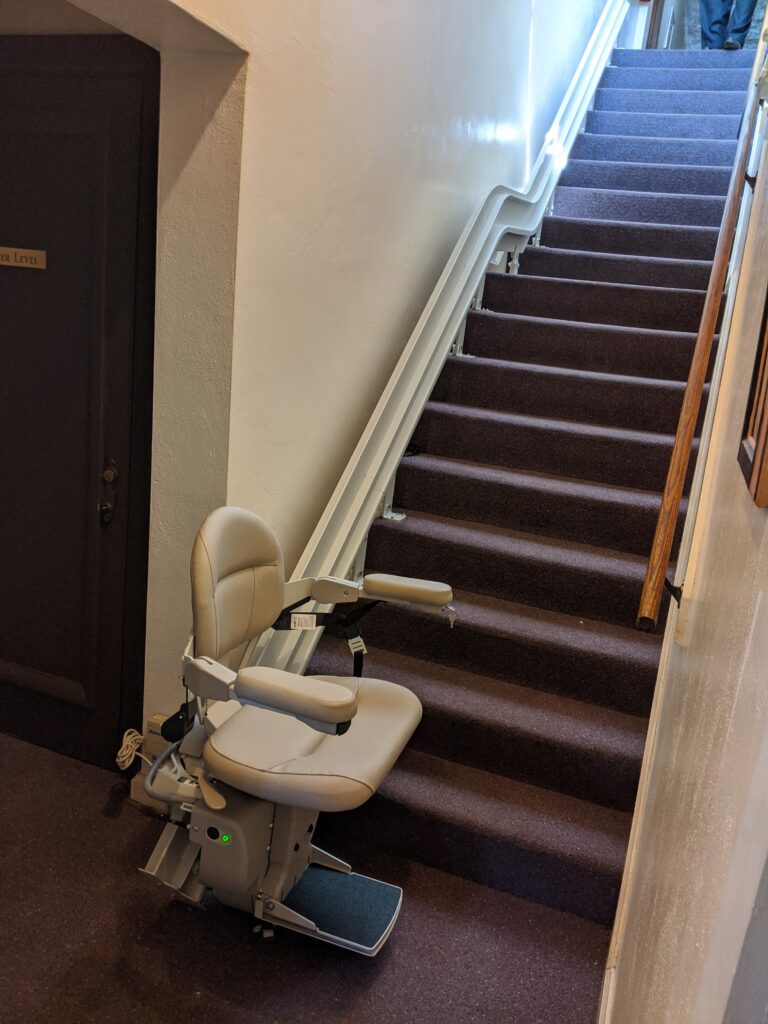
Stair lifts are a cost-effective, easy-to-operate, and construction-free way of gaining mobility and independence throughout your home. If you are researching stair lift costs for yourself or a family member, it can be frustrating not to find an exact price online. Additionally, many resources end up over-simplifying the shopping process for stair lifts, creating unrealistic expectations and delaying the significant improvement a stair lift can make to one’s life.
While typically you can find pretty accurate pricing for, say, a car or home online, determining stair lift costs requires answering more than a dozen questions about the unique circumstances of the home, staircase, and stair lift user. On top of that, your answers to these questions may still lack the insight of a professional evaluator, causing you extra headaches and unforeseen costs.
The truth is that there’s no substitute for having a qualified Stair Lift Expert evaluate your home based on the answers to 17 specific questions. An in-home evaluation from an experienced company like Arrow Lift will result in a reliable quote for your stair lift costs without any high-pressure sales tactics — just clear guidance on the pricing process so you can make informed decisions on your timeline.
With these considerations in mind, let’s look deeper into the questions to ask to better understand the factors affecting stair lift costs.
1. Where is the stair lift being installed?
The city, state, or ZIP code of the home where the stair lift will be installed affects many things, including stair lift pricing. When the cost of living varies, the cost of providing an accessibility lift varies along with it. For example, stair lifts cost more in California than in Iowa.
2. What type of building will the lift be installed in?
Most stair lifts are installed in private homes. However, they can also be installed to enhance accessibility in non-residential settings, such as churches, temples, veterans halls, fraternal lodges, and commercial buildings. It’s important to note that stair lifts are not ADA-compliant because individuals in wheelchairs cannot use them without transferring in and out of their wheelchairs.
For several reasons, in-home stair lifts cost less than commercial stair lifts:
- There is a different safety code for residential versus commercial stair lifts.
- It often makes sense to purchase a heavy-duty model for a commercial setting since it may be used by the general public rather than a specific individual.
- Permit and inspection costs are typically higher for non-residential stair lifts.
3. Will the stair lift be installed inside or outside the building?
Stair lifts can be made for indoor or outdoor use. Outdoor stair lifts cost more than indoor stair lifts because they’re made to be weather-resistant and often contain extra parts, such as a weatherproof cover to shield the upholstery from the elements when the chair is not in use.
4. Is a new or used stair lift being considered for purchase?
Some types of stair lifts are suitable for reconditioning and resale by experienced stair lift companies. When there is a used stair lift available, it costs less than a brand-new unit. Of course, the warranty for a used stair lift is less robust than the warranty for a comparable new unit, but you should still receive a written warranty for parts and labor.
5. Is the staircase straight, or does it turn?
The answer to this question and #6 below have the most impact on the cost of installing a stair lift. This is because stair lifts are made in one of two ways: if the stairs are straight, the installation company cuts the rail to length; if the stairs turn, the rail is custom-made for the stairs. Customizing the rail of a stair lift has advantages, but it also comes at a higher cost (and with a longer lead time).

6. Are there any intermediate landings in the staircase?
As far as stair lifts are concerned, this question is just another version of asking if the stairs turn. Sometimes, a “straight” staircase has one flight of stairs, followed by an intermediate landing, followed by another flight of stairs. It is impossible (and unsafe) to install a single, straight-rail stair lift in these situations. Instead, a custom-rail stair lift is needed. While this custom rail is often called a curved rail stair lift, sometimes it is installed on a straight staircase.
7. How long is the staircase?
Depending on your situation, the length of the stairs may impact the cost of materials, labor, or both. Fortunately, every stair lift quoted by Arrow Lift is a firm quote, not an estimate, so you will know precisely how much the cost will be when you decide to purchase.
8. What does the layout at the bottom of the stairs look like?
Believe it or not, the layout at the lower landing of the staircase is usually more important than the layout at the top of the staircase when it comes to stair lift costs. This layout will determine the shape of the rail at the lower landing for custom and curved rail stair lifts.
For straight rail stair lifts, it will determine whether you need a retractable rail (also called a folding rail) at the bottom. This is one of the most common stair lift upgrades based on safety considerations because a standard straight rail sticks out about 18 inches at the bottom of the stairs. In some situations, this would cause an unsafe tripping hazard for people in the home when the chair is parked at the top of the stairs, which is common. To address this safety concern, a retractable rail at the bottom of the stairs makes it so that the bottom of the rail does not protrude past the bottom step nose, eliminating the tripping hazard.
9. What is the weight and size of the person using the stair lift?
Stair lift chairs are not one-size-fits-all devices, which is one reason why Arrow Lift has multiple local stair lift showrooms where you can try before buying. In addition to some individuals finding that one stair chair model is more comfortable than another, each model has a different weight capacity. Stair lift weight capacity can vary from 250 to 600 pounds, and most stair lift models are in the 300- to 400-pound weight capacity range.
10. What are the physical abilities and challenges of the individual(s) who will use the lift?
Just as stair lifts are not one-size-fits-all regarding the chair, different models have different features to suit various challenges and ability levels. One example is how the chair will swivel at the top of the staircase. The swiveling seat mechanism is the most essential safety feature on a stair lift, and all stair lifts come standard with a manual swivel seat.
However, to operate the swivel seat, the user needs to push or pull a small lever next to the seat and turn their body toward the upper landing. For some users, this is easy, and for others, it is not (another reason to try it in a showroom first). Those with difficulty manually swiveling the stair lift chair can use an automatic swiveling chair. Automatic, or power, swivel seats move at the touch of a button, making it much easier for some individuals to operate the stair lift safely.
Other examples of how an individual’s physical challenges might impact stair lift costs include seat belt options beyond the standard lap belt, such as a five-point harness or ankle restraints. Individuals who cannot control their body movements while riding the stair lift can benefit from these optional seatbelt upgrades, which cost more than the standard seatbelt.
Lastly, the size of the stair lift footrest and the way it folds up (manually or automatically) can make a significant difference to many users and can also impact the cost of the lift.

11. What are the mental abilities of the person?
Just as physical abilities factor into stair lift costs, so do mental abilities. The most common example is the inclusion of a power swivel for someone forgetful or likely to be confused by the manual swivel lever mechanism.
In some cases, families may also choose to purchase a curved rail stair lift for a straight set of stairs, so that the track continues onto the upper landing. This allows their loved one to exit the chair well away from the stairs (as opposed to exiting right at the top of the stairs). This is less common because the swivel mechanism addresses this concern in the vast majority of situations. However, it does happen, and when it does, can influence cost.
12. Do you have preferences regarding the usability and safety features of the stair lift?
Some of the features above, such as seatbelt style and automation options, come down to personal preference or safety concerns. Some stair lift models have seatbelts that are more likely to be used, while others have very basic seatbelts that are out of the way and often get forgotten.
Likewise, the way a footrest folds at the top of the stairs and the desire to fold the stair lift up when not in use might influence the choice of stair lift models. Experiencing multiple options in person often comes in handy when making these decisions.
13. Do you have any preferences on how the stair lift looks?
While some of our clients want to purchase the most affordable stair lift that meets their needs and fits their home, it is not uncommon to want something that matches or coordinates with the home’s interior. In some cases, the same lift that’s most affordable looks the best! However, in other cases, an optional upholstery upgrade or a particular rail color might be significant in the purchase decision. Such upgrades are available on some stair lift models at an additional cost.
A few questions primarily affect feasibility, though sometimes impact cost, as well. They are as follows:
14. Where is the nearest electrical outlet?
Most of the time, your Arrow Lift Stair Lift Expert will be able to locate a nearby outlet close enough to the stairs so as not to require extra work or costs. However, the distance between the stairs and the outlet can sometimes limit the stair lift models available or require an electrician to install an outlet closer to the stairs.
15. How wide are the stairs?
Most staircases built in the last 50 years or so are 36 inches wide and have plenty of room for a stair lift. However, feasibility and cost issues can arise with extra-narrow staircases, heavy-duty requirements (because heavy-duty stair lifts take up more space), and extremely tall users. Most stair lifts work on most staircases for most users, but not all stair lifts work on all staircases for all users!
16. Are there any intrusions into the staircase, such as handrails, overhangs, etc.?
Because stair lifts attach to the stair treads rather than the wall and are more compact than many people think, it is not uncommon for Arrow Lift to install a stair lift on a staircase with handrails. In other situations, the handrails must be removed (or relocated to the other side of the stairs) before the stair lift installation. Finally, any object or structural element that overhangs the stairs will need to be evaluated by a trained Stair Lift Expert in advance to ensure that the chosen stair lift works flawlessly on your stairs.
17. What is the layout at the top of the staircase?
Some stair lift models cannot be installed on staircases with a door at the top. Other models can be installed if special parts are used to modify the rail angle. Lastly, some models are designed to work in these scenarios as-is, with no special parts or additional costs. For curved stair lifts, the layout at the top of the staircase might also determine where the stair lift parks when not in use.
Consider the Alternatives
There is one final note regarding stair lift costs: consider not just the cost of the stair lift itself but also the context of the other options you may have.
Stair lifts are almost always less costly than other types of lifts and elevators (although home elevators and wheelchair platform lifts do offer greater versatility and other benefits). They are also nearly always less expensive than moving, not to mention the benefits of staying in a home you love. And, in a worst-case scenario that we hope does not happen to you or your loved one, stair lifts usually cost less than the medical bills after a dangerous fall on the staircase. If cost is your primary concern, please read about the top 10 ways to pay for a stair lift.
Given all the questions and possible answers above, playing it safe and consulting a seasoned, local stair lift company makes sense. We recommend choosing a BBB-accredited, family-owned stair lift company that takes a consultative approach. And if you can visit a local stair lift showroom, all the better! We hope to serve you and help you find the right stair lift for you or your family.
 Since 1985, Arrow Lift has been in the business of helping our customers overcome barriers. From
Since 1985, Arrow Lift has been in the business of helping our customers overcome barriers. From 